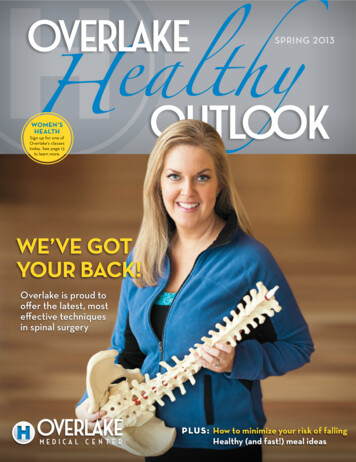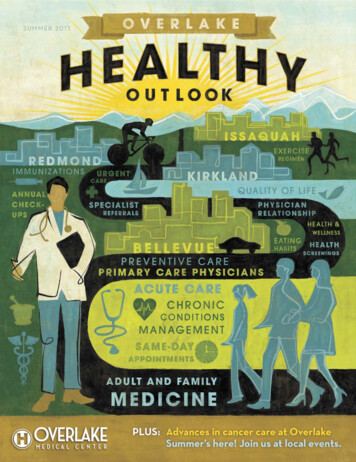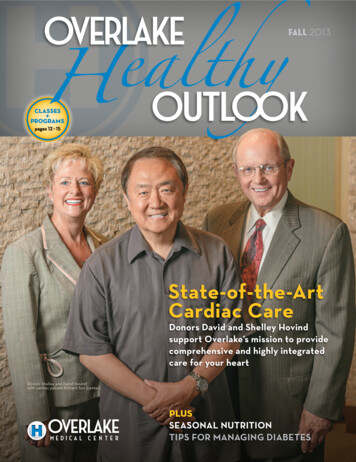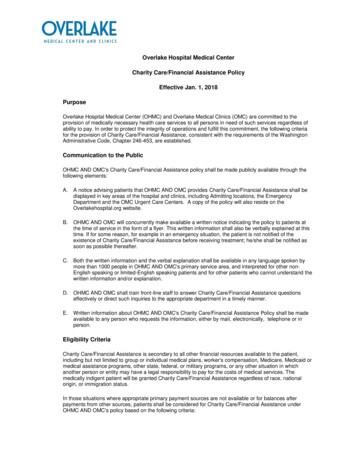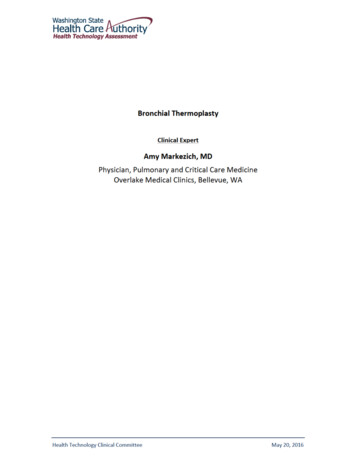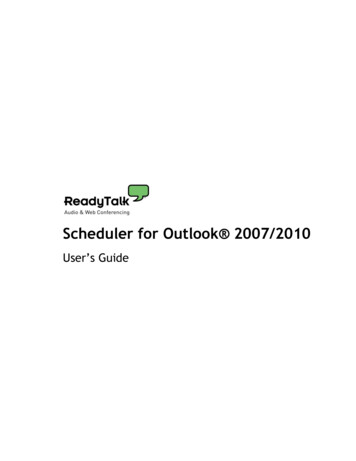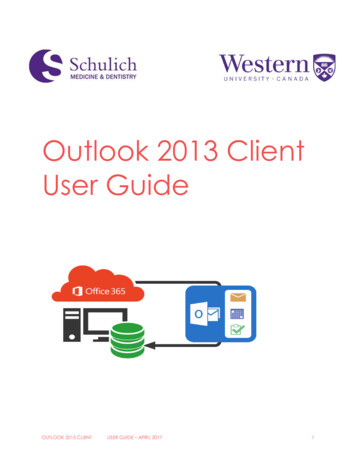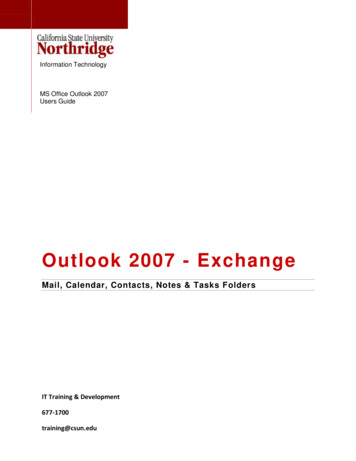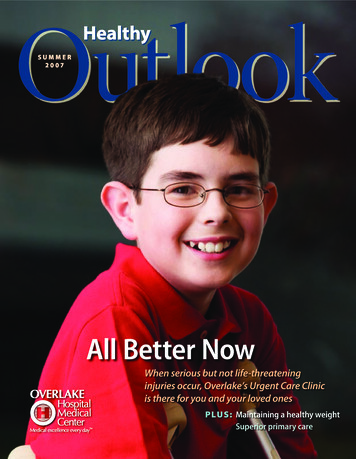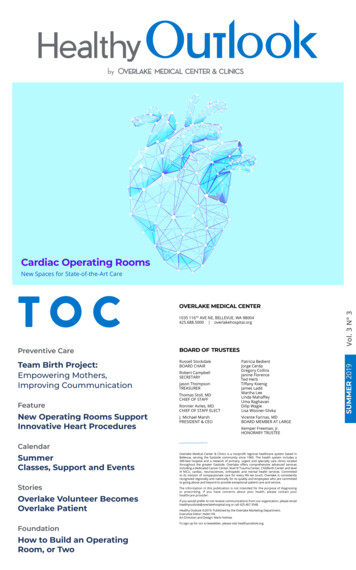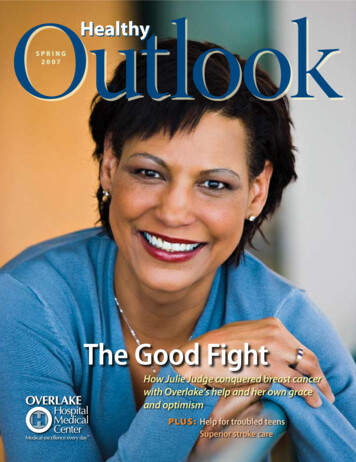
Transcription
OutlookHealthySPRING2007The Good FightHow Julie Judge conquered breast cancerwith Overlake’s help and her own graceand optimismPLUS: Help for troubled teensSuperior stroke care
From the President & CEOWe’ve talked quite a bit in the past year about the merits of our newSouth Tower and its importance within our community. While it’sexciting to be expanding our campus, we know that a better futureisn’t about buildings. It’s about the people who are healed in themand our ability to provide state-of-the-art technology and exceptional healthcare to each and every life we touch.As a nonprofit, non-tax-supported organization, OverlakeHospital Medical Center depends on broad community support tostay at the forefront of medical technology. Fundraising is a criticalcomponent, bridging the gap between what the hospital receives inreimbursements and payments and what it takes to run a regionalmedical center.Thanks to community support and philanthropy, Overlake’stwo most recent Bandage Balls raised funds that supported thepurchase of a new CT scanner for the South Tower and four digitalmammography units for our Breast Center. These are significanttechnological improvements that provide even greater efficiencyand accuracy for the patients we serve.This generous support means so much to our organization andto me personally. We are able to be a superb, growing hospitalbecause of the community which supports us so wholeheartedly.We understand that providing high-quality healthcare to our everexpanding region is crucial. This is a key priority for Overlake, andI promise to keep you informed as our plans unfold for additionalservices in the communities we serve.Sincerely,Overlake Receives Primary StrokeCenter DesignationIn January, Overlake received certification ofits multifaceted Stroke Program from the JointCommission. The designation as a Primary StrokeCenter enables Overlake to continue providing Eastsidepatients with leading-edge stroke care, recognizingthat through evidence-based medicine and a standardized approach, the hospital can decrease the disabilityand mortality caused by strokes.Stroke Program Director RecognizedGregory Gorman, MD, a board-certified neurologistand Overlake’s Stroke Program director, was one of 50neurologists in the nation who recently received boardsubspecialization certification in behavioral neurology.This new subspecialty involves the study and care ofpatients with brain disorders that cause problems withthinking and remembering.CORRECTION: In our last issue, we incorrectly listed thephone number to call for more information on bone densitytesting offered at our Issaquah Women’s Center. The correctphone number is 425-467-3630. We regret the error.Craig HendricksonPresident & CEOOv e rl a k e H ospi ta l M e d i c a l C e n t e rH e a lt h y O u t loo k S P R I N G 2 0 07Board of TrusteesLarry HebnerGregory Engel, MDCarol Clemettchairmanchief of staff electJim DoudJerome E. MathewsCraig HendricksonKemper Freeman Jr.1035 116th Ave. N.E.Bellevue, WA 980046520 226th Pl. S.E.Issaquah, WA 98027425-688-5000w w w. ov er l a k eh ospi ta l . o r gOverlake Hospital Medical Center is a nonprofit, independently operated, voluntary regionalmedical center offering, in association with medical staff, a wide range of health technologiesand specialty services. Earnings are devoted exclusively to the continuation and improvement ofpatient services and facilities, as well as educational, outreach and research activities. Theinformation in this publication is not intended for the purpose of diagnosing or prescribing. Ifyou have concerns about health issues, contact your personal physician.immediate past chairman president and ceoCecily HallJohn MurphyDouglas AlbrightPeter Horvitzsecretaryhospital counselKen JohnsenTom ClevelandClodagh AshDoug MartintreasurerPearl BarnesSkip RowleyStephen Marshall, MDJeanne W. CarlsonPeriodically, we send communications to friends and neighbors in our community that describethe healthcare services and products we offer. If you would prefer not to receive communications like this from our organization, please call 425-467-3548.chief of staffThomas H. Castle Jr., MDHealthy Outlook 2007. Published by the Overlake Hospital Marketing Department. Photography by Scott Areman.Healthy Outlook
ComprehensiveStroke CareAccording to the American Heart Association,more than 750,000 Americans suffer a newor recurrent stroke every year. It’s the thirdleading cause of death in the U.S., taking the lives ofnearly 157,000 people a year. More than 80 percent ofstrokes are ischemic strokes caused by a clogged vesselthat blocks the flow of blood to the brain. Blockagesare caused by fatty deposits inside the vessel, calledatherosclerosis, or hardening of the arteries.The most common treatment for stroke is using“clot-busters,” also known as thrombolytic therapy.This standard procedure involves injecting a clotbusting drug (tPA) into a vein in the arm, or directlyinto the brain artery near the clot or blockage. Thelatter treatment method can sometimes dissolve theclot faster.To enhance care for the nearly 400 stroke patientswe treat each year, Overlake Hospital Medical Centerrecently launched a comprehensive, integratedStroke Program. The program has earned Overlakethe designation as a Primary Stroke Center from theJoint Commission.In addition to providing patients with a full rangeof effective treatment options, Overlake’s StrokeProgram offers rapid, early response, rehabilitation and caring support. “The most critical programcomponents involve educating the community andemergency medical technicians about the importanceof fast action in response to stroke, as well as the factthat there is hope and reliable treatment for strokepatients,” says Carole Hardy, RN, Overlake StrokeProgram coordinator.As part of the program, a dedicated team of caregivers in theEmergency Department mobilizes all stroke-related resources, including diagnostics, interventional radiology, laboratory, pharmacy andneurology, so that patients receive the immediate care needed to prevent brain cell loss and disability.Stroke patients are given specialized care in the stroke units, wherethe clinical staff has in-depth training in neurological assessment andstroke, aspiration risks and prevention, and certification in advancedcardiac life support (ACLS). The care team also includes physical therapists, occupational therapists and speech therapists to help with anyrehabilitation needs, with the goal of beginning rehab within 24 hoursof a patient’s admittance to the hospital.In addition, Overlake offers education and support for strokepatients so they can prevent recurring strokes and get back to theirroutine as quickly as possible. A Stroke Mentor Program is staffed byvolunteers, some of whom are former stroke patients. These volunteersshare their experiences and provide ongoing guidance.For more information on Overlake’s Stroke Program, contactCarole Hardy at 425-688-5600.WANT TO LEARN MORE ABOUT STROKE?Overlake offers four educational programs onstroke— Acting Against Brain Attack , BrainAttack, Fighting Back Against Brain Attack andLife Line Screening . For details, see our classand program listings beginning on Page 12.Spring 2007
BeatItold the doctor, ‘Whileyou’re saving my life,I’m living it,’”says Julie Judge, a charismatic mother of two and nationalsales manager for five well-known Seattle radio stations.“I didn’t want to play the victim. It was easier for me to goabout my normal life and take a positive outlook.”Judge has now joined the ranks of over 2 millionbreast cancer survivors in the U.S. today. The keyto those numbers is early detection and treatment.According to the American Cancer Society (ACS), “Theearlier breast cancer is found, the better the chances thattreatment will work. The goal is to find cancers beforethey start to cause symptoms.”One of the first lines of defense against breast canceris getting a mammogram. The ACS recommends thatwomen age 40 and older have a mammogram every year.For Judge, this early detection was crucial. “A monthafter my 49th birthday, I noticed a lump,” she recalls.She immediately scheduled an appointment with herOb/Gyn who, after an exam, sent her to the OverlakeBreast Center for a diagnostic mammogram.There are two types of mammograms. A screeningmammogram is an X-ray exam of the breast in a womanwho has no symptoms. Judge received a diagnosticmammogram, which is designed for women who havea breast complaint or have had an abnormality found
[ CANCER CAR E ]ingBreast CancerJulie Judge Fought Back with Strength and Humorduring a screening mammogram. During a diagnosticwith her busy work and travel schedule throughout her treat-mammogram, more pictures are taken to focus on suspi-ments. “I didn’t really have any major side effects from any ofcious areas. Unlike most hospitals, where radiologists studythe treatments. I was a little tired, and I lost my hair—but IX-rays and images from all areas of the body, Overlakegot a great wig!” she recalls. “I just wanted to keep things asHospital Medical Center has three dedicated breast radiolo-normal as possible. It gave me less time to moan.”gists who work exclusively in the Breast Center.After radiologists pinpointed the suspicious area, theyShe credits the Overlake team with helping her managethe demands of eight months of breast cancer treatments, onscheduled Judge for a needle biopsy that same day. Usingtop of motherhood and a busy career. “It’s definitely a teama thin needle, physicians removed small samples of tis-approach at Overlake,” she says. “I could tell they were work-sue from the area in question for further study. The resultsing together, because one physician would mention somethingdetermined that cancer was indeed present, so Judge wasI’d spoken with another physician about. They really did areferred to an oncologist and a breast surgeon.good job of communicating with each other and with me.”“I never said, ‘Why me?’” remembers Judge. “I actuallyIn fact, Overlake’s breast cancer program is unique infelt pretty lucky, because I knew that if you catch breastthat physicians meet weekly to discuss every patient, not justcancer early, you don’t die from it.”some selected patients as in most other facilities. “HavingJudge’s oncologist, Tanya Wahl, MD, recommended shemultiple physician specialists’ input can often mean a betterundergo chemotherapy prior to surgery in order to shrinkprocess,” states Overlake breast radiologist David Magaram,the cancer so that it would be small enough to be removedMD. He explained that teamwork is crucial when a patientby lumpectomy. Lumpectomy is a surgical procedure tolike Judge is seeing multiple physicians, from breast radiolo-remove the breast lump and a small amount of surroundinggists to medical oncologists and radiation therapy specialists.tissue. Another surgical procedure is mastectomy, which is“We’re a very collegial team,” says Overlake breast surgeonused less often than lumpectomy, and involves the removalKristi Harrington, MD. “I have no problem walking down theof the entire breast. Either surgery may include removinghall to talk to a physician about a particular patient.” Also, atthe lymph nodes under the arms.Overlake’s Breast Center, oncologists, radiation therapy, andFollowing a successful surgery, Judge underwent radia-breast surgeons are located adjacent to one another. “The facttion therapy to kill cells in the area of the cancer and to keepthat all of our facilities are geographically close,” she says,them from growing and dividing. She managed to keep up“makes that communication easier.”Spring 2007
[ CANCER CAR E ]The Fight GoesHigh TechNew digital mammography, dedicatedMRI and MammoSite radiationMammography Goes DigitalJust as digital cameras revolutionized the home photography market,digital mammography is revolutionizing diagnosis and treatment forbreast cancer. Not only does digital mammography provide fasterexams and lower radiation, but with digital tools, physicians canmanipulate the images to better detect small calcifications or otherchanges in the breast.Overlake will soon be providing digital mammography for everypatient, thanks to the generosity of the Overlake Hospital Auxiliaries.Proceeds from this year’s Bandage Ball funded the technology. (Seepage 10 for more information.)“Particularly in younger women and those with dense breasts,digital mammography provides greater screening sensitivity,” saysKathryn Crossland, MD, an Overlake oncologist.In fact, a recent study in The New England Journal of Medicinestated that “the accuracy of digital mammography was significantlyhigher than that of film among women under the age of 50.”“And for those patients who are diagnosed with breast cancer, theclinical advantages are extremely valuable,” says David Magaram,MD, one of Overlake’s dedicated breast radiologists. “Now, if a breastsurgeon is in the operating room and has a question for the radiologist, we can both pull up the file and look at the same picture, fromtwo locations, without having to physically be in the same roomtogether looking at a piece of film.”“There is also a huge advantage in not having to worry about misplacing films,” adds Dr. Magaram. “A patient with breast cancer oftenhas to see numerous physicians and, at each point, must bring herfilms along. Digital files make those images easy to copy and share.”MRI Adds Extra Layer of DetectionMagnetic resonance imaging (MRI) has becomeanother helpful ally in the diagnosis and treatment ofbreast cancer. An MRI uses magnets and radio wavesto produce detailed, cross-sectional images of the body.The only MRI completely dedicated to breast exams inthe Pacific Northwest is located on Overlake’s campus.“Because the MRI is used only for breast patients,it is engineered to optimize imaging for those types ofpatients,” says Dr. Magaram. “Especially for high-riskpatients, with a family history of breast cancer, MRI isa tremendous asset in detection. And because it provides such helpful information on the true extent of thecancerous cells, it is becoming a common practice foralmost everyone with a diagnosis of breast cancer.”Radiation TreatmentAdds Convenience FactorOn the treatment side, Overlake Radiation Oncologyoffers the convenient option of high dose rate (HDR)radiation for certain patients utilizing MammoSite technology. Rather than using a machine that focuses raysfrom outside the body, MammoSite works by deliveringradiation from inside the breast. A thin catheter is usedto insert a tiny radioactive seed inside the lumpectomycavity. The seed then delivers a high dose of radiationto the area most at risk for recurrence. Because the areais treated from the inside out, the normal surroundingtissue receives a decreased radiation dose.Convenience is key with MammoSite therapy. It canbe completed in only five days, as opposed to five to sevenweeks with conventional radiation. “The whole point ofthese new developments is to provide options for womenwho need this treatment,” says James Pelton, MD, a radiation oncologist at Overlake.“Women have confidence in our program when theysee how focused we are on offering the best options outthere,” says Overlake breast surgeon Kristi Harrington,MD. “It’s important to continue to look for these newertechnologies, so that we can customize treatment plansfor each unique patient.”To make an appointment for a screening mammogram,call 425-688-5985, or visit www.overlakehospital.organd click on Breast Health Scheduling in the Patients &Visitors Section. Screening mammograms are availablein Bellevue and Issaquah.
Heather Osterman-Thorne, who works in the Women’s and Infants’ boutiqueOverlake is fully committed to serving residents inIssaquah and its neighboring communities. That’s whywe have comprehensive services for women on ourIssaquah campus.Help for New MothersOverlake offers a postpartum follow-up program to help newmoms and babies through those critical first days at home.For those who live in the Issaquah area, the program canbe accessed at the Issaquah Women’s Clinic in our LakesideII/Meadow Creek campus. The program provides a checkup formom and baby, three to five days after birth, to ensure adequatefeeding and overall good health. The clinic also has a freeweight station that can be used anytime during office hours tomonitor a baby’s weight.Breastfeeding support is offered to new mothers who wouldlike additional education or for those who are having breastfeeding problems. Hospital-grade, electric breast pump rentalsand other nursing accessories are available, as are bra fittings tohelp new mothers find the nursing bra that is right for them.Overlake also schedules parenting classes in Issaquah thatare geared toward first-time moms and dads, including: Preparation for Childbirth and Newborn Care. You & Your New Baby, for mothers with infants 4–12weeks old. Conscious Fathering, for new dads after baby arrives.Women’s Care in IssaquahAthena Urology . . . . . . . . . . . . . . . . . . . . . . 425-899-4646Overlake Breast Imaging . . . . . . . . . . . . . 425-688-5985Issaquah OB/GYN . . . . . . . . . . . . . . . . . . . . . . 425-391-8886Medical Arts Group of Issaquah . . . . . . . . 425-837-8842Women’s Servicesin Issaquah Baby Boot Camp , a fitness program for postpartummoms and their babies.For a full list of classes, call 425-688-5259 or log on to www.overlakehospital.org. Click on the Health & Wellness link, thenClasses at Overlake.Another unique offering at the Women’s Clinic is theWomen’s and Infants’ Boutique, which carries an array ofpersonal items and relaxation products, maternity suppliesand gifts. Expectant and new moms can find nursing clothing,birthing and massage balls, and prenatal abdominal supportbelts and binders. There’s plenty for baby too; preemie andnewborn clothing, blankets, baby carriers, slings, hats andmuch more.Midlife ScreeningsWomen in midlife can conveniently take care of two procedures with one appointment: a mammography screening and abone-density screening. The American Cancer Society recommends an annual screening mammogram starting at age 40.To identify the risk of developing osteoporosis, bone densityis measured with The MetriScan device, a tabletop unit thatestimates bone density in the three middle fingers of a woman’shand. The test takes only seconds to perform, and results areimmediate.The Issaquah Breast Screening Center offers appointments Monday through Friday, 8 a.m. to 4:30 p.m. Please call425-688-5985 or schedule your appointment online atwww.overlakehospital.org and click on Breast HealthScheduling in the Patients & Visitors section.LocationConveniently located near I-90, the center is at 6520 226th Pl.S.E., Ste. 130 in the Urgent Care building. Free parking is abundant. For more information, call 425-467-3630.Overlake OB/GYN . . . . . . . . . . . . . . . . . . . . . . 425-391-8655Overlake Women’s Services . . . . . . . . . . . . 425-467-3630Spring 2007
Adolescent Day Programbrings help and hopeMany parents ask at some point, “Does my teen needhelp with an emotional problem? Is this behaviornormal?” Some amount of uncertainty, questioning and conflict is inherent in raising children, and moodvariations are typical during a child’s development. For somefamilies, though, the problems are significant enough thatseeking outside help can be a lifeline, turning a child andfamily toward wellness.“I encourage any family profoundly struggling with a childor teen’s behavior to give us a call,” advises Francis Shih, MD,an Overlake adolescent psychiatrist. “We can help sort outwhat services are appropriate.” Problems that deserve attention are usually pronounced and impact daily living. “Whenfamily members and teachers are concerned about a child’semotional and physical well-being, I suggest seeking outsidehelp,” says Dr. Shih.One study showed that 13 percent of young Americansages 9 to 17 years old suffer from an anxiety and panic disorder that can impact the activities of daily life. Up to 3percent of children and 8 percent of adolescents suffer fromdepression, which affects energy, appetite, sleep, interestin daily activities and overall functioning. Depression cansignificantly impact a child’s ability to function well at homeand at school. Extreme shifts in moods may be caused bybipolar disorder, which affects 1 percent of children.Overlake offers the Adolescent Day Program, a servicecustom-fit for teens who are struggling with these and otherissues. Programs such as Overlake’s are quite rare because ofa nationwide shortage of psychiatrists specializing in treatingteens. The program, in an attractive office park building afew miles from the hospital, was described by one teenageras “just like going to classes to learn to deal with my depression.” This unique service provides children and adolescentswith intensive, comprehensive treatment without overnighthospital stays. The goal is to offer the treatment that kidsneed, while minimizing the disruption for families and Healthy Outlookschools. It is a good fit for a child who is not at imminent riskto self or others, and who has a support system at home.The Adolescent Day Program is multidisciplinary. Patientsand families benefit from an adolescent psychiatrist trained inthe special needs of teens, plus psychiatric registered nurses,master’s level social workers, certified therapeutic recreationspecialists, occupational and physical therapists, and otherprofessionals. For children ages 12 and older with more acuteneeds, Overlake offers inpatient hospitalization for rapid stabilization. Another service, the Psychiatric Intensive OutpatientProgram, provides brief intensive therapy meetings, typicallyover a three-week time frame.If you have a teenager in your life who is struggling,consider seeking help. Overlake offers same-day or next-dayoutpatient evaluations for both children and adolescents(ages 3 to 18), depending on the urgency. Staff can be alwaysreached by phone or pager. For more information, please call425-688-5460.Adapting to Reality:Managing Behavioral Health Issuesin the Hospital (and Community)Overlake is proud to sponsor this all-day symposiumon April 17 for nurses and other healthcare providers.It will cover common mental health diagnoses and disorders, as well as how to manage associated behaviorsthrough nursing interventions, strategies and medication therapy in order to support the patient’s recovery.For more information, please call 425-688-5882 ore-mail eugenia.stull@overlakehospital.org. The symposium is made possible through an endowment for“Advancement of Nursing and Clinical Education” byJohn and Hazel Matheson.
NeurosciencesTodayOne in five Americans suffers from a neurological disorder,such as Alzheimer’s, Parkinson’s or chronic pain. As ourpopulation ages and lives longer, the incidence of neu-rological disease will likely increase to as many as one out of twopeople facing the prospect of losing independence, productivityand quality of life due to a brain or nervous system malfunction.Overlake’s Neurosciences Program offers board-certifiedneurosurgeons and neurologists working together as a comprehensive team with skilled nurses and other caregivers to providestate-of-the-art diagnostic, therapeutic and rehabilitative servicesto patients living with a wide range of neurological diseasesand disorders that affect the brain, spinal cord, spinal column,OVERLAKE NeurologistsErik R. Armitano, MD. . . . . . . . . . . . . . . . . . . . . . . . . . . 425-899-6200A. Thomas Collins, MD. . . . . . . . . . . . . . . . . . . . . . . . . 425-455-5440Jeffrey E. Dunn, MD. . . . . . . . . . . . . . . . . . . . . . . . . . . . 425-455-5440Daniel P. Fosmire, MD. . . . . . . . . . . . . . . . . . . . . . . . . . 425-709-7055D. Gregory Gorman, MD. . . . . . . . . . . . . . . . . . . . . . . 425-709-7055Rodney Johnson, MD. . . . . . . . . . . . . . . . . . . . . . . . . . 425-455-5440Joseph J. Robin, MD. . . . . . . . . . . . . . . . . . . . . . . . . . . 425-455-5440Randip Singh, MD . . . . . . . . . . . . . . . . . . . . . . . . . . . . . 425-289-3000James Yumin Song, MD. . . . . . . . . . . . . . . . . . . . . . . . 425-455-5440OVERLAKE NeurosurgeonsVarun Laohaprasit, MD. . . . . . . . . . . . . . . . . . . . . . . . . 425-455-5440Ali Naini, MD. . . . . . . . . . . . . . . . . . . . . . . . . . . . . . . . . . . 425-455-5440Jeffrey E. Pearce, MD. . . . . . . . . . . . . . . . . . . . . . . . . . . 425-455-5440Jacob N. Young, MD. . . . . . . . . . . . . . . . . . . . . . . . . . . 425-456-0922Christopher Smythies, MD. . . . . . . . . . . . . . . . . . . . . 425-456-0922For more information or to find an Overlakeneurologist or neurosurgeon, please call ourphysician referral line at 425-688-5211 or visitwww.overlakehospital.org.nervous system and peripheral nerves. This includes treatment for diseases and disorders such as brain and spinalcord tumors, Parkinson’s disease, carpal tunnel syndrome,migraine, multiple sclerosis, epilepsy, sciatica, slippeddiscs, spinal stenosis, neck and back pain, and sportsrelated head injuries.The first step toward an effective treatment is anaccurate diagnosis, which involves getting a patient’sdetailed health history and neurological tests for vision,strength, coordination, reflexes, and sensation. “Our goalis to diagnose what is wrong and work with our patients todevelop the optimal treatment plan, whether that includessurgery or not,” says Christopher Smythies, MD, Overlakeneurosurgeon. “Perhaps surprising to some, we operateon roughly 25 percent of our patients, as surgery is usedas a last resort.” For example, many cases of back pain canbe treated with anti-inflammatory medication, physicaltherapy and muscle relaxants. Overlake neurosurgeonJeffrey Pearce, MD, also explains that, “With today’s activepopulation getting older and living longer, we spend nearly70 percent of our time treating patients with more commonspine and peripheral nerve problems.”For patients who do require surgery, Overlake’s team ofneurosurgeons utilize cutting-edge medical tools, as well asless invasive surgical equipment and techniques, which arechanging the way many neurological disorders are treated.“We have much better instrumentation and equipmenttoday than we used to,” notes Dr. Smythies.For example, cervical plates (medically designedimplants) are used during spinal procedures to provide neckstability, which may reduce the need for external bracingfollowing surgery. Also helpful is the opportunity to get bonefrom a bone bank rather than having to take bone graftsfrom a patient’s hip. “These advances help to eliminate themost painful parts of surgery for patients, as well as enhanceour ability to care for our patients,” says Dr. Smythies.Spring 2007
[ foundation & A uxiliarie S ]Overlake Hospital Auxiliaries would like to thank the following businessesand individuals for their support of the 20th Anniversary Bandage Ball:Pr e sent i n g Sp o ns o rB EN EFAC TOR Sp o ns o r sArthur J. Gallagher RiskManagement ServicesChevronGroup Health CooperativeOgden Murphy Wallace, PLLCPr i nci pa l Sp o ns o r SCascade PlazaGLY ConstructionH o n o r a ry Ch a i r sBob and Joan WallaceE v ent Ch a i rMary OdermatA successful businesswoman in the private banking industry, Sue Smith isalso an Overlake Hospital Foundation Board member, proud Eastsideresident, wife and mother of two.Below, she shares her family’scommitmentto Overlakeand why they choose to support the hospital.“When my husband Greg and I moved from Dayton, Ohio, toSammamish eight years ago, we immediately took an interest inOverlake. It’s our community’s hospital and it is important to us.“I joined the Overlake Hospital Foundation Board in 2003. Witha young and active family, I knew someday we would be in need ofOverlake’s services. And I was right. Both my daughter and my sonhave landed in the Overlake Emergency Department, each havingvery positive experiences despite serious ailments. Their care washandled professionally, swiftly and, perhaps most important,respectfully. Our son’s caregivers explained why they were seeinghim, what they were going to do and exactly what was happening.For a kid who had never been in a hospital before, it was extremelyreassuring to receive that kind of personalized care.“We have consistently supported Overlake, and this year wealso made a contribution to the Overlake South Tower CapitalCampaign. We know that the new South Tower will greatly addto the hospital’s capabilities and help it meet the needs of our10Healthy Outlookgrowing Eastside community. We’ve witnessed the community’stremendous growth firsthand in the short time we’ve been hereand know that it will continue for years to come. This is why it isso crucial that Overlake’s resources be at their best, for when ourcommunity needs them the most.“We all hope that our loved ones won’t need to use a hospital’sservices, but when that time does come, everyone wants to havethe very best care made available to them, in the most comfortablesurroundings. But it takes money to make that a reality. That’swhy Greg and I choose to donate both our time and our money tosupport Overlake.“Much like you, I enjoy living in this beautiful region and appreciate all it has to offer. I am especially grateful for Overlake—atrue community hospital dedicated to caring for each person withcompassion, respect and medical excellence.“I hope you will join my family in support of Overlake.”
YourWill is VitalIf you passed away without a will or revocable living trust, or with onethat is outdated, how would it affect those you care about? If you findyourself among the 50 percent of Americans who do not have an upto-date will, it is essential that you take action now.If you do not have a will, state law would determine your assetdistribution at your death. An outdated will might result in theimproper disbursement of yo
OB/GyN who, after an exam, sent her to the Overlake Breast Center for a diagnostic mammogram. There are two types of mammograms. A screening mammogram is an X-ray exam of the breast in a woman who has no symptoms. Judge received a diagnostic mammogram, which is designed for women who have a breast complaint or have had an abnormality found
